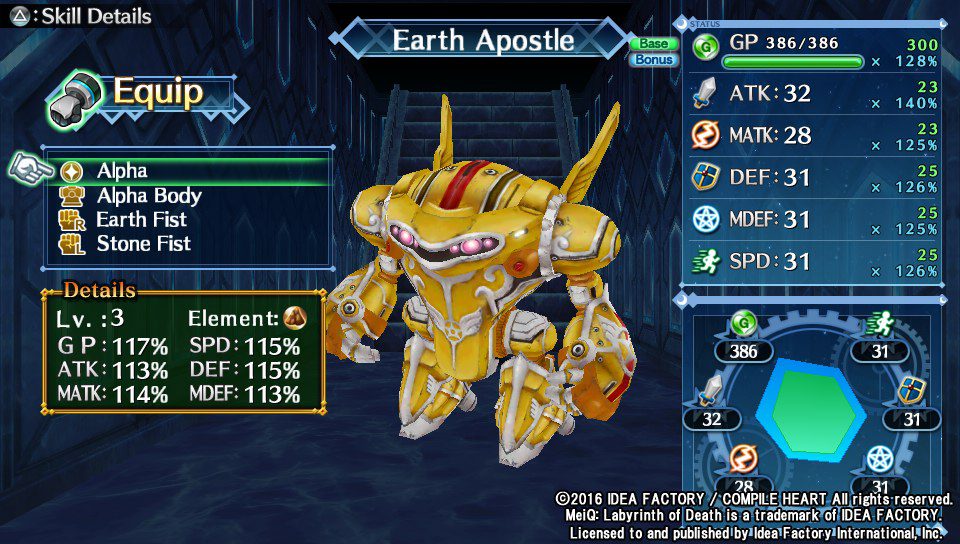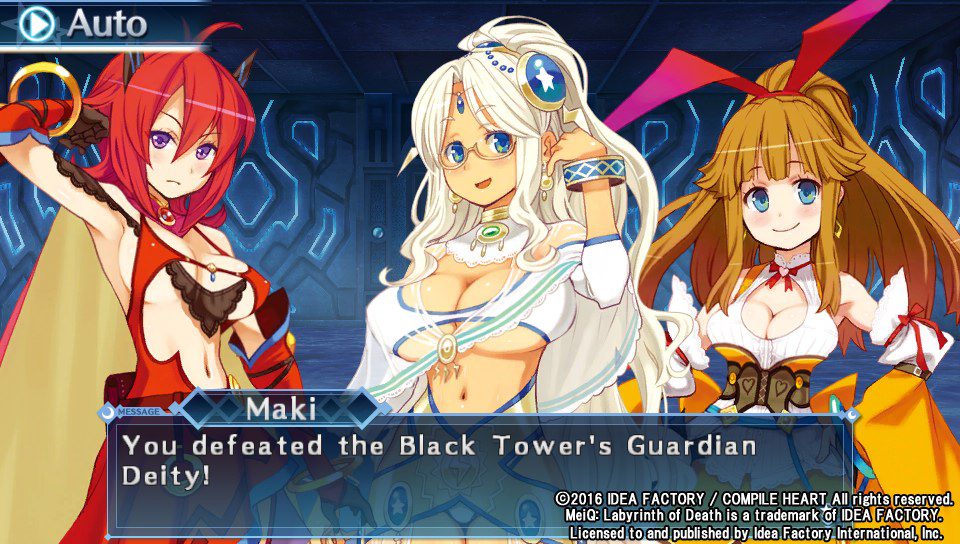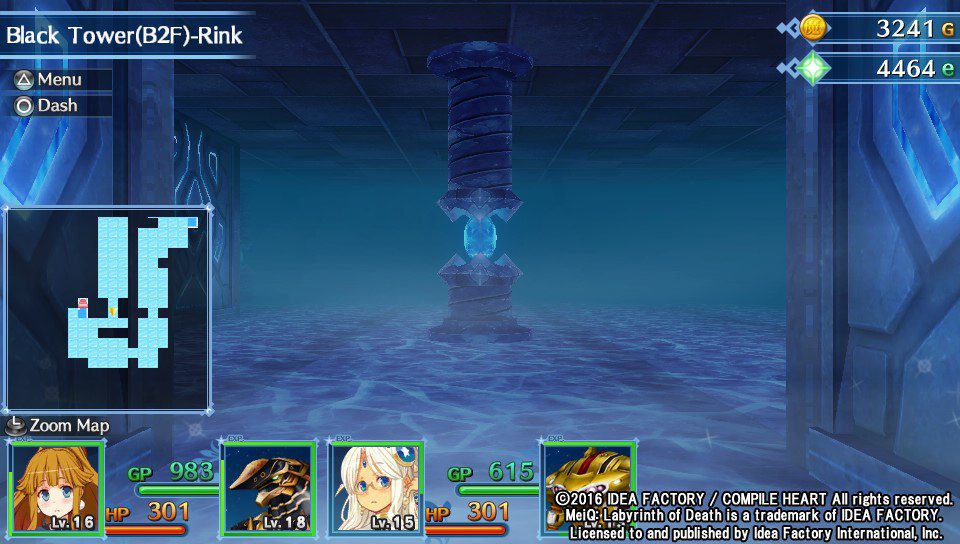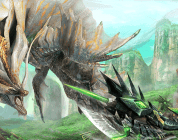Dungeon crawlers are downright abundant on the PSVita, probably more so than any other console of today or yesterday. Even at the international level, which is weird considering how these games mostly have been successful in the hands of Japanese players, but these games have caught on over the years. Most of the dungeon crawlers utilize that telltale first-person exploration, slowly uncovering maps, and having some sort of RPG battle system at its core. I’ve played probably ten games in this genre ever since joining Marooners’ Rock, some being games I can’t stand, while others have interesting components, but I’ve never played a smash hit in this style. MeiQ: Labyrinth of Death is another one of these dungeon crawlers and while it doesn’t do anything spectacular or particularly unique, I found myself coming back to it more and more.
MeiQ is all about a world in which the stars have stopped giving off their glow, including the sun, putting the world into an eternal darkness. In this darkness, monsters thrive, putting the world in the hands of five chosen Machina Mages who must wind up the Celestial Screw in order to bring things back to order. To do this, the five Mages must take on four towers, each with deadly, multi-layered dungeons. Along the way they face opposition in the form of the Three Shadows, who also wield similar magic. The Machina Mages must use their robotic Guardians wisely in order to achieve their ultimate goal.
Players will be using these mechanical Guardians as their main line of defense against the monsters in a traditional turn-based combat system. Each of them are customizable, being able to swap both arms, body type, and their cores. Each of these parts change stats of the character, with a huge focus being on what element they are and what sort of damage they utilize. This simple version of Pokemon‘s effectiveness combat is what drives the major tactical decisions. Guardians are not the only way to battle though.
As the game goes on, players will be able to add the other four Machina mages to their party, choosing three Mages and three Guardians to make up a full party. Much later in the game that party expands once more to four Mages and four Guardians, but for the most part the player will be using three of each. These Mages are the heroes of the game’s plot, with each of them wanting to be the one who winds the Celestial Screw, but as things become more dangerous they are forced to work together. Estra, the Machina Mage of Earth (the main character), uses her kindness to bring the other mages together, often sharing Guardian cores to get them back in the fight after defeat.
Each Mage has her own spells (they are all ladies) to sling with each being attuned to a particular element. In battle, each turn can either be given to the Mage or the Guardian with the Guardian tanking most of the damage of enemy attacks. However, using a Mage to attack leaves them open and losing all your Mages ends the game. Choosing what characters to use at the best times makes the combat system fun, if a bit repetitive. Boss battles usually test the player’s wits, as many of them become easier if multiple abilities are used. Of course, having the proper gear set up always helps too.
Aside from battling, much of the game is presented in other two ways, a visual novel for the story and a first-person crawl for the dungeons. These dialogue scenes are nothing to write home about, with many of the conversations feeling pretty silly. Even the later parts of the game rarely stray into good prose. What’s also important to note in the narrative is a much smaller cast of characters. There are probably less than twenty characters in MeiQ, which is actually refreshing. I always get frustrated with these dungeon crawlers having way too many characters to keep track of; MeiQ keeps it simple.
All of the female characters though, have that sexy anime girl problem with way too much focus being put on the girls’ breasts. There’s even an animation put in that has the breasts swell a bit with each breath; its pretty ridiculous once noticed. I don’t mind this sort of fan-service in games, it just didn’t add anything to the game for me and I’m the type of guy who loves Miss Kobayashi’s Dragon Maid or Yoko from Gurren Lagann. Some players may really enjoy this aspect though, but don’t expect a ton of ecchi moments like there were in Fairy Fencer F, which was my last reviewed game.
Dungeon crawling is pretty standard in MeiQ, walk around and fill up the spaces on a map, getting into fights with monsters along the way. Each dungeon has its own gimmicks, like the forest having one way doors that disappear into bramble once a player goes through. Another dungeon has pillars of fire blocking the way and only beating a dragon in another tower will release their hold on the team’s progress. Even though it initially felt like a way to pad out the game’s length, I actually enjoyed the backtracking forced onto the player. After beating a dungeon, there will be times where the player has to go back to it, either to find new floors or track down a hidden boss. For most this will feel tedious, but for me it made the dungeons feel more like a part of this small little world.
Exploration at large is pretty limited as everything in the game happens in one main city. All the shops and locations are picked from a menu, but its so minimal that I didn’t mind it. Usually, these dungeon crawlers have me confused with the sheer number of menus, but I found MeiQ to be just the right amount of information to get by with to keep the player in the dungeons. Also important to mention is the streamlining MeiQ does. Battles can be fast-forwarded by holding the ‘X’ button. Hitting a corner automatically turns the player to keep moving and a lot of dungeons are designed around that fact. All dialogue can be clicked through quickly or set to a solid pace with the Auto mode. It made playing the game feel quick and snappy, something that is rare in these sort of games. Its this interface that actually got me into the game as playing always felt like it was set to the pace I determined. That and I do enjoy some Magical Girl narratives, so one with robots seemed like a good fit for me thematically.
As far as the plot goes, I’m still hoping it becomes some sort of battle royale, dark and gritty story later on. There is lots of mention of only one Machina Mage being able to wind the Celestial Screw, so I imagined the girls would be forced to kill each other in the end. As of now though, I haven’t seen any of this as I have yet to finish the game. I’ve only beat three out of the four towers and I’ll have to give an update or something if I ever reach the end. It’s not like I’m not enjoying playing, there’s just not much to motivate the player, no real dire-feeling circumstances to rush progression. MeiQ just feels like a quick distraction, something that could easily have been a twelve episode anime show.
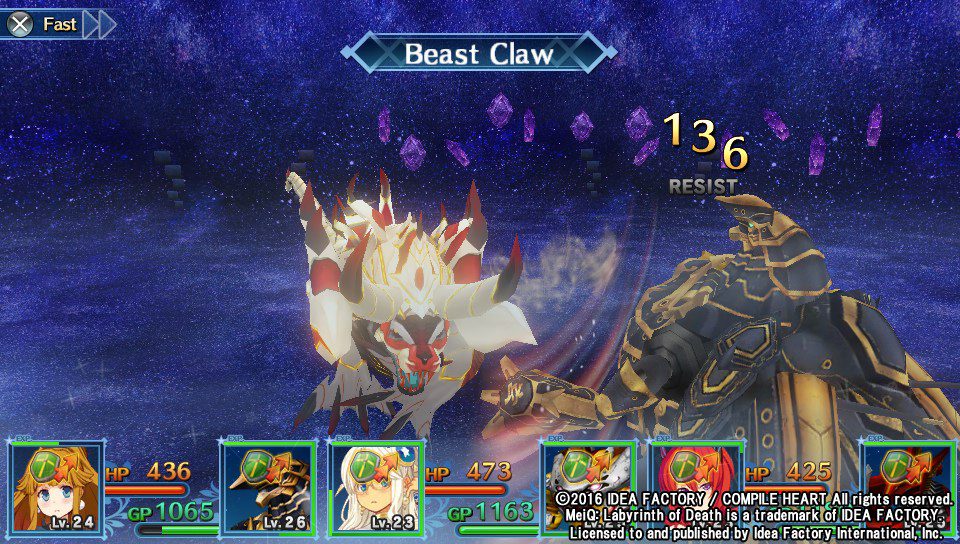
Boss fights really challenge the player’s knowledge on the elemental tables and what skills need to be utilized.
All in all, MeiQ: Labyrinth of Death is a solid portable game, one that I hope to be revisiting to steadily make my way to the end. There is nothing super spectacular about the game, but its clever use of mechanics that make it play on a faster pace if wanted is definitely refreshing. The combat is easy to pick up and understand with some clever nuances hidden beneath the surface. I loved customizing the Guardians with various parts and finding what tactics were the most effective. Honestly though, the characters lack any substantial personalities and the plot is so desperately asking for a darker spin. Yet, the combat and speed I could play at was addictive and I’m eager to see how the game wraps up.
Dungeon crawler fans will have a ton of simple fun with MeiQ: Labyrinth of Death. Having another good game for the criminally underrated PS Vita is definitely a benefit.
For more information, check out the official website.

